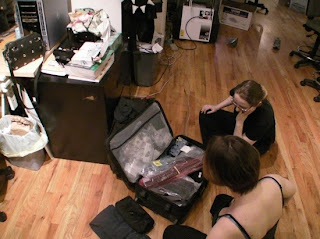This weekend was an exercise in what must be a successive approximation of ISO9000 compliance for PCB assembly. I went down to Adafruit Industries and my hostess provided me with: a MetCal; a fume extractor; a pair of diagonal cutters and a bit of her invaluable time over a 36-hour window. With these ingredients, I magically transformed a 65# suitcase of components into 20 laboratory EKG amplifiers. Then I used her laser cutter to mark (for drilling) and label all of the enclosures. It was one hell of a transfer function.

Fig 1. The Input

Fig 2. The Output
Between this and the 2009 Ninja Networks Party DefCon Badge assembly extravaganza, I'm overdue in giving a breakdown of how to bring medium and large-scale PCB assembly into the reach of a DIY-crew with enough time, enthusiasm and lack of OSHA oversight*. There are tons of things you can do in your home (but preferably in some borrowed industrial workspace) to assemble your own production-quality PCBs for low overhead -- and there's absolutely nothing mystical about how 90% of electronics are made. All the nebulous magic is reserved for how to make staggering volumes of things cheaply, quickly and reliably -- a process which Bunny has already demystified.
*OSHA really doesn't like it when you drink beer at your bench.
*OSHA really doesn't like it when you drink beer at your bench.









